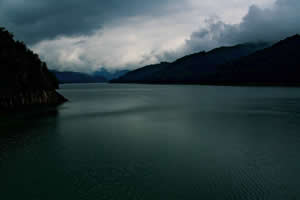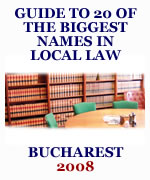Secrets in the water
Natural and non-polluting but in need of a makeover, hydro power is the Cinderella of Romania’s power generators
 |
|
|||||||||||||
Despite an energy crisis in the rest of the world, the first four months of 2008 saw a 11 per cent rise in electricity production in Romania compared to the previous year.
This is mainly due to a rainy period for hydro power, as well as a new nuclear reactor coming online at Romania’s power station in Cernavoda.
The country already supplies around 30 per cent of its electricity demand through hydro power. This is due to a massive Communist-era programme to build several hundred hydro power stations.
“While Romania decided to develop the hydro power programme, Bulgaria bet on the nuclear-power station Kozlodui, but in the end we won,” says Jean Constantinescu, president of the Romanian Institute for Energy Development Studies (IRE).
The hydro power programme is not just a renewable energy source, because a station prevents floods in its area and helps agriculture to develop, as well as preventing the erosion of the soil, supplying cities and villages with water, creating fish farms and preparing a foundation for tourism and water sports.
But hydro power also destroys ecosystems and forces the relocation of communities, which is why some environmentalists oppose radical dam and flooding projects.
Romania is one of the only European countries which has exploited such a high quota of its hydro power potential.
But this came at a great cost.
“I don’t know how Romania could have survived the transition period after Communism if it had not had the small prices of electricity generated by hydro power,” says Constantinescu. “This keeps saving us and helps us remain below the gas emissions limits imposed by the international community.”
During the 1970s, the country spent the equivalent of billions today in combination with former Yugoslavia to create giant hydro power station such as Iron Gate (Portile de Fier I and II) in Caras Severin county on the Danube.
To undertake this scale of public works is unimaginable today due to the massive upfront costs needed for such a project.
“The hydro programme should be turned into a national priority because now even large energy companies would not dare to spend billions of Euro to build hydro power stations as complex as Portile de Fier,” Constantinescu adds. “Unfortunately the hydro programme was not seriously considered by the Government’s strategy after 1990.”
Many argue that such heritage should not be allowed to deteriorate, but should see new investment to maintain its full potential and increase its efficiency.
Hydro energy has another advantage because it modulates the generated electricity according to the demand. Usually hydro power works in tandem with nuclear power. When the nuclear reactors in Romania’s power station on the east coast in Cernavoda refuel or stop operation for check-ups, the national electricity supply drops by 700 MW per reactor. This shortfall is replaced by hydro power. If it operates at maximum capacity, hydro power can replace, in the short term, a further 15 per cent of the national electricity supply, which is exactly how much energy nuclear provides in Romania.
Selling time
Now the hydro power sector is witnessing a shake-up. State-owned hydro power company Hidroelectrica aims to increase the country’s hydro power potential from 48 to 62 per cent between 2005 and 2025 by developing new production facilities and modernising the old plants. This will need support from private companies willing to invest in new projects and rehabilitate existing plants.
The Government has decided to sell about 150 micro hydro power plants with an installed power capacity of lower than ten MW. These only account for about 2.1 per cent of hydro power’s energy estate.
From the 81 so far sold, 48 units were bought by Romanian companies and the rest of 33 plants were acquired by foreign companies especially from Italy, Austria, Portugal, France and Germany. Last June state firm Hidroelectrica sold 17 micro hydro power stations located especially in Moldavia to Austrian Wienstrom for 28 million Euro.
Gaz de France is also interested in buying some hydro power plants, but is only interested in stations with an installed power capacity of more than ten MW. The French giant has not participated yet in the public auctions organised by Hidroelectrica.
Oil and gas group Petrom, which is owned by Austria’s OMV, is also interested in investing in hydro energy in Romania, but the hydro power stations that Hidroelectrica has put up for sale are also too small.
“These small units weren’t efficient and profitable when operated by the state, because the maintenance services were not made in due time, but I am sure private investors will do a better job,” says Constantinescu.
He hopes the privatisation process is careful to avoid the risk that micro hydro power stations do not end up in the hands of real estate developers, but with investors who want to continue generating electricity.
When the privatisation process is over, Hidroelectrica will continue to oversee 205 hydro power stations.
Waiting for the champion
The Ministry of Economy and Finance plans to add Hidroelectrica to its national energy company project designed to include state-owned companies which have evaded privatisation. Electricity distribution companies Electrica Muntenia Nord, Transilvania Sud and Transilvania Nord along with thermo power complexes Rovinari and Turceni are planned to be part of the energy company.
Hidroelectrica general manager Traian Oprea says the project could be “interesting” providing the ‘champion’ has the structure of a holding company, which would allow each separate ‘firm’ some degree of independence in its management.
But a curtain of silence has fallen on the specifics of the Government’s plan, leaving power companies in Romania clueless as to what state bodies are up for privatisation and which ones will remain under Government control and in what kind of structure.
“Nothing is happening in [major] hydro sector privatisations for the moment because of the energy champion project, which Hidroelectrica should be part of,” says Lacramioara Diaconu, director of Petrom’s Power Division. “We hope that the situation will be clarified after this year’s general elections.”
Green is not what it seems
Romania should be able to capitalise on the fact that up to 33 per cent of its power generated already comes from renewable energy – due to its hydro power estate.
But the regulators have decided that only hydro power stations which have been modernised since 2004 constitute green energy. This means the signficant majority of these stations are not a suitable resource for a renewable energy trading scheme.
There are two incentive systems to encourage renewable energy - green certificates and feed-in tariffs. With feed-in tariffs, electricity suppliers must buy renewable electricity at above market rates to off-set the high costs of renewable power generation.
Green certificates are tradable environmental commodities representing one MW/hour of electricity produced by green energy. The producer can sell this ‘certificate’ on a specific market in addition to its sale of electricity.
In the mid-1990s, the EU promoted competition between different types of renewable energy. From this, the green certificates system emerged. Currently around seven EU member states use it.
Now in Romania there is a green certificate system which is applicable between 2005 and 2012, but has some teething problems. The Government has issued a draft law, which is now under parliamentary debate, to clarify the status of green certificates in Romania.
Now every supplier has to purchase a percentage of green energy which the authorities set at the beginning of a year. If the supplier fails to fulfill this quota, it should receive a penalty from the regulatory authorities.
This is set to rise. For 2007 this quota was set to 3.74 per cent of the total electricity quantity delivered to consumers. The authorities set for 2008 a quota of 5.26 per cent and, for 2009, 6.78 per cent. Between 2010 and 2012, each electricity supplier has to buy green certificates according to the 8.3 per cent quota set per year.
But there are two problems – this system is not honoured and the energy from renewable resources is not available in Romania to buy.
Last year green certificates were available for only eight MW of installed power capacity from wind and 52 MW from hydro power stations modernised after 2004.
At the end of the year, when the authorities realised the quota had not been fulfilled, they set a lower retrospective threshold to not upset the investors. In 2007 the regulatory authority ANRE lowered the quota from 3.74 to 2.62 per cent.
Petrom’s deputy CEO Lacramioara Diaconu says that because the quantity of renewable energy produced in Romania is so small, the demand for green certificates is massive. The current trading price for a green certificate is almost twice the maximum level imposed by the law. But electricity suppliers have to buy them or risk penalties.
The price for one green certificate should be, by law, between 24 and 42 Euro.
“We had to pay 70 Euro for a certificate for our oil refinery in Brazi, simply because there is practically no one who sells them in Romania and the demand is very high,” says Diaconu. “If Romania had a functional green certificates market we would pay between 24 and 42 Euro, but no one has certificates because almost no one is producing [renewable energy] and the situation will continue until the first wind farms will start producing in the next two to three years.”
The Diplomat asked the president of the regulator ANRE Gergely Olosz to comment on this and other issues, but he refused bluntly an interview.
A major flaw of the legislation in renewable energy is that the current framework based on green certificates is only available until the end of 2012.
“Beyond that nobody knows what will happen,” says Diaconu. “This makes it difficult to start a project considering that in wind energy, for example, it takes about four to five years to finish developing a project and start producing electricity.”
Report written by
Ana Maria Nitoi

















